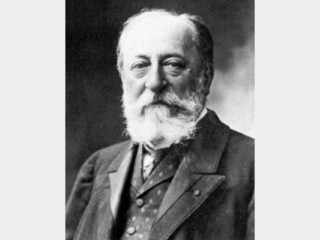
Camille Saint-Saëns biography
Date of birth : 1835-10-09
Date of death : 1921-12-16
Birthplace : Paris, France
Nationality : French
Category : Famous Figures
Last modified : 2011-02-09
Credited as : Composer, conductor and pianist,
The French composer Charles Camille Saint-Saëns wrote music in almost every form and medium, characterized by polish and skill although lacking in ultimate depth or passion.
Born in Paris into a moderately poor family, Camille Saint-Saëns began his musical education by studying piano with his grandaunt. As a child, he exhibited considerable talent in performance and composition. He made his official concert debut as a pianist at the age of 11 and 2 years later was admitted to the Paris Conservatory. He studied composition with Jacques Fromentin Halevy and won prizes in organ in 1849 and 1851. Saint-Saëns's dexterity at this instrument, coupled with his ability to improvise, led in 1853 to his appointment as organist at the church of St-Merry and 5 years later at the Madeleine. From 1861 to 1865 he taught piano at the Ecole Niedermeyer.
In 1871 Saint-Saëns helped found the National Society of Music, an organization devoted to the encouragement of young French composers, but he withdrew 5 years later as his essentially conservative nature had come into conflict with the changing interests of the younger composers. He resigned from his position at the Madeleine in 1877 and spent the following years touring North and South America, England, Russia, and Austria, conducting and performing his own compositions. Highly honored in his lifetime, he was admitted into the French Legion of Honor in 1868, gaining its highest order, the Grand-Croix, in 1913. He was outspoken against the music of Claude Debussy and the French impressionist school.
The compositions of Saint-Saëns include five Piano Concertos, of which the Second (1868) and the Fourth (1875) hold a secure place in the repertoire today. His Introduction and Rondo Capriccioso for violin and orchestra (1870) is better known than his other concertos. Among his symphonic poems the Danse macabre (1874) is probably his most popular composition. Its charm lies not only in its melodic appeal but in the delightful way in which Saint-ëns imitates Death playing his out-of-tune violin and the rattling of the bones as the skeletons dance. Another composition that reveals his sense of humor is the Carnival of Animals (1866); the lovely cello solo "The Swan" comes from this work. More impressive than these occasional compositions is the Third Symphony (1886), the orchestration of which includes an organ as well as piano. His only operatic success, Samson et Dalila (1877), contains the well-known aria "My heart at thy sweet voice" and a colorful bacchanale.
In addition to his activities as composer and performer, Saint-Saëns was also the general editor of the complete works of Jean Philippe Rameau. The English conductor Sir Thomas Beecham, in an oft-quoted statement, called Saint-Saëns the greatest second-rate composer who ever lived.
Considerable biographical information is in Saint-Saëns's autobiographical book, Musical Memories (1913; trans. 1919). James Harding, Saint-Saëns and His Circle (1965), is the most important study of the composer in English. Saint-Saënsisone of the subjects of Donald Brook, Five Great French Composers (1946).
















